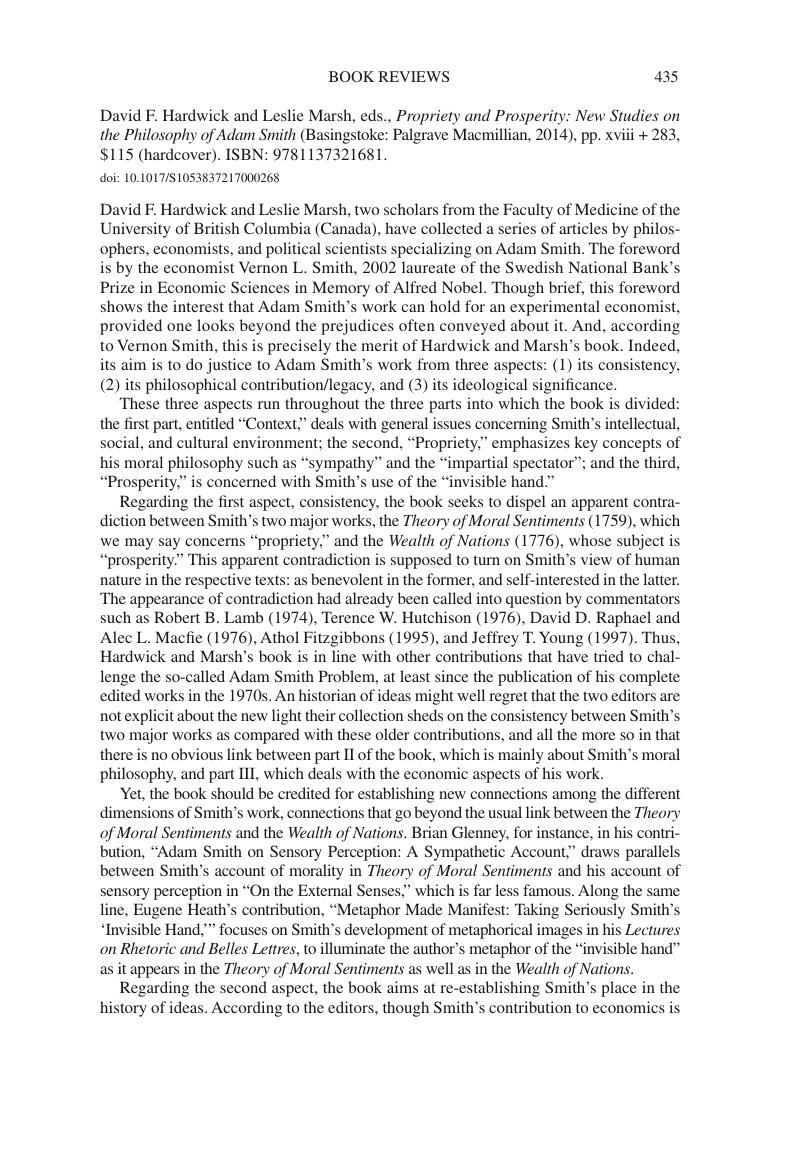No CrossRef data available.
Article contents
David F. Hardwick and Leslie Marsh, eds., Propriety and Prosperity: New Studies on the Philosophy of Adam Smith (Basingstoke: Palgrave Macmillian, 2014), pp. xviii + 283, $115 (hardcover). ISBN: 9781137321681.
Review products
David F. Hardwick and Leslie Marsh, eds., Propriety and Prosperity: New Studies on the Philosophy of Adam Smith (Basingstoke: Palgrave Macmillian, 2014), pp. xviii + 283, $115 (hardcover). ISBN: 9781137321681.
Published online by Cambridge University Press: 05 July 2018
Abstract
An abstract is not available for this content so a preview has been provided. Please use the Get access link above for information on how to access this content.

- Type
- Book Reviews
- Information
- Copyright
- Copyright © The History of Economics Society 2018
References
REFERENCES
Biziou, Michaël. 2003. Adam Smith et l’origine du libéralisme. Paris: Presses Universitaires de France.Google Scholar
Bréban, Laurie. 2012. “Sensitivity to Prosperity and Adversity: What Would a Smithian Function of Happiness Look Like?” European Journal of the History of Economic Thought 19 (4): 551–586.CrossRefGoogle Scholar
Fitzgibbons, Athol. 1995. Adam Smith’s System of Liberty, Wealth, and Virtue: The Moral Foundations of the Wealth of Nations. New York: Oxford University Press.Google Scholar
Frazer, Michaël L. 2012. The Enlightenment of Sympathy: Justice and the Moral Sentiments in the Eighteenth Century and Today. New York: Oxford University Press.Google Scholar
Hutchison, Terence W. 1976. “The Bicentenary of Adam Smith.” Economic journal 86: 481–492.CrossRefGoogle Scholar
Lamb, Robert B. 1974. “Adam Smith’s System: Sympathy Not Self-Interest.” Journal of the History of Ideas 35: 671–682.CrossRefGoogle Scholar
Levy, David M. 1999. “Adam Smith’s Katallactic Model of Gambling: Approbation from the Spectator.” Journal of the History of Economic Thought 21 (1): 81–91.CrossRefGoogle Scholar
Meardon, Stephen J., and Ortmann, Andreas. 1996. “Self-Command in Adam Smith’s Theory of Moral Sentiments: A Game-Theoretic Reinterpretation.” Rationality and Society 8 (1): 57–80.CrossRefGoogle Scholar
Nanay, Bence. 2010. “Adam Smith’s Concept of Sympathy and Its Contemporary Interpretations.” In “The Philosophy of Adam Smith: Essays Commemorating the 250th Anniversary of The Theory of Moral Sentiments.” The Adam Smith Review 5: 85–105.Google Scholar
Pack, Spencer J. 1991. Capitalism as a Moral System: Adam Smith’s Critique of the Free Market Economy. Aldershot: Edward Elgar.Google Scholar
Palacios-Huerta, Ignacio. 2003. “Time-Inconsistent Preferences in Adam Smith and David Hume.” History of Political Economy 35 (2): 241–268.CrossRefGoogle Scholar
Raphael, David D., and Macfie, Alec L.. 1976. “Introduction.” In Raphale, David D. and Macfie, Alec L., eds., The Theory of Moral Sentiments. Oxford: Clarendon Press, 1976: 1–52.Google Scholar
Smith, Adam. [1776] 1976. An Inquiry into the Nature and Causes of the Wealth of Nations. Oxford: Clarendon Press, 1976.Google Scholar
Winch, Donald. 1978. Adam Smith’s Politics: An Essay in Historiographic Revision. Cambridge: Cambridge University Press.CrossRefGoogle Scholar
Young, Jeffrey T. 1997. Economics as a Moral Science: The Political Economy of Adam Smith. Cheltenham and Lyme: Edward Elgar.Google Scholar




